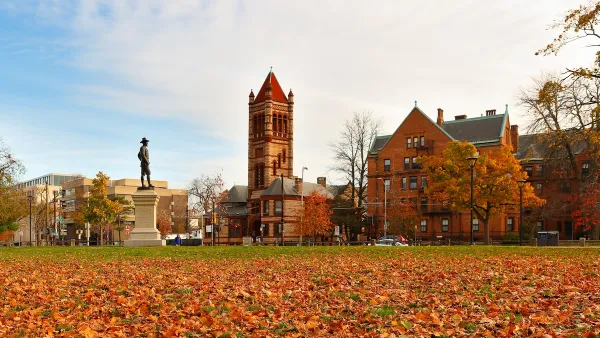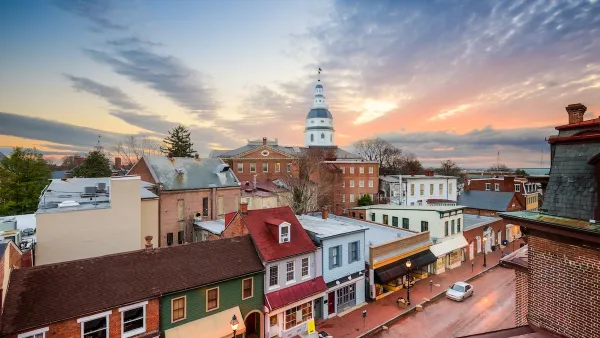Research supports the argument that increased densities reduce vehicle miles traveled, even in areas with minimal transit service.
A few weeks ago, I read a startling claim in an email discussion group. Someone wrote that at densities above 20 households per acre (roughly that of a streetcar suburb),* increased density had little effect on driving. If this was the case, the environmental argument for allowing higher densities would obviously be weaker.
After searching for data relevant to this claim, I found a 1994 study by John Holtzclaw (available here). Based on data from numerous California cities, Holtzclaw created a model designed to quantify the relationship between density and automobile vehicle miles traveled (VMT).**
Holtzclaw concluded that even in areas with minimal transit service, density affected VMT. For example, in an area with only two buses per hour, a census tract with 20 households per acre drove about 40 percent less per household than one with two units per acre (15,374 per year as opposed to 27,339). But VMT did not stop dropping at the 20 households per acre level. An area with 100 households per acre drove 1/3 fewer miles than the 20-per-acre neighborhood (10,028 VMT per household) and one with 500 households per acre drove 40 percent less than the area witih 100 households per acre (5781).
A similar density/VMT relationship existed in areas with generous public transit. Holtzclaw calculated that in a place with 100 buses/trains per hour within a quarter mile, a census tract with 2 units per acre produced 20,308 VMT per household per year, and a tract with 20 households per acre produced about 45 percent fewer miles (11,420). Under these circumstances, an area with 100 households per acre drove about 1/3 fewer miles than the 20-units-per-acre census tract (7637), and an area with 500 households per acre drove about 40 percent less than the area with 100 per acre (4295).
VMT statistics in actual neighborhoods supported Holtzclaw's model. For example, in the city of San Francisco, VMT per household averaged 11,256 miles. By contrast, in the Nob Hill/North Beach area (which had 100 households per acre, as opposed to 48 for the city as a whole) VMT per household was less than half that (5519). In sum, it appears (at least based on Holtzclaw's model) that even at densities of 100 households per acre or more, higher density means less driving.
Moreover, Holtzclaw's model may slightly understate the influence of density on driving. Why? Because higher density, by allowing more people to live near bus or train stops, makes improved transit service possible- which itself seems to reduce driving.***
Why does any of this matter? Because if the most compact neighborhoods drive less than 20 household-per-acre streetcar suburbs, it follows that additional infill in already-compact neighborhoods, by increasing density, will reduce VMT. If this is the case, then additional infill is justified on environmental grounds, even in neighborhoods that are already far more compact than the average American suburb.
*Because there are 640 acres in a square mile, this corresponds to 12,800 households per square mile in a heavily residential area. San Francisco's Sunset District has roughly this density, as do the more compact parts of Upper Northwest Washington, DC.
**The numbers produced by Holtzclaw's model are at Table 7 of the paper.
***Though perhaps not as much as higher density. For example, in the super-dense neighborhood with 500 units per acre, the difference between 2 buses per hour and 100 per hour produced a change from 5781 VMT/household/year to 4295- a change much smaller than the difference between either neighborhood and the lower-density areas.

Analysis: Cybertruck Fatality Rate Far Exceeds That of Ford Pinto
The Tesla Cybertruck was recalled seven times last year.

National Parks Layoffs Will Cause Communities to Lose Billions
Thousands of essential park workers were laid off this week, just before the busy spring break season.

Retro-silient?: America’s First “Eco-burb,” The Woodlands Turns 50
A master-planned community north of Houston offers lessons on green infrastructure and resilient design, but falls short of its founder’s lofty affordability and walkability goals.

Test News Post 1
This is a summary

Analysis: Cybertruck Fatality Rate Far Exceeds That of Ford Pinto
The Tesla Cybertruck was recalled seven times last year.

Test News Headline 46
Test for the image on the front page.
Urban Design for Planners 1: Software Tools
This six-course series explores essential urban design concepts using open source software and equips planners with the tools they need to participate fully in the urban design process.
Planning for Universal Design
Learn the tools for implementing Universal Design in planning regulations.
EMC Planning Group, Inc.
Planetizen
Planetizen
Mpact (formerly Rail~Volution)
Great Falls Development Authority, Inc.
HUDs Office of Policy Development and Research
NYU Wagner Graduate School of Public Service





























